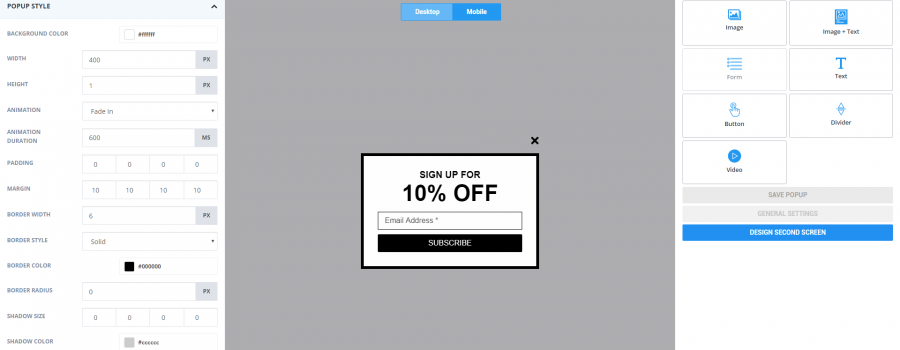9 Metrics for Evaluating Your eCommerce Email Marketing Performance

You’re tracking open rates, click-through rates, and bounce rates, and hardly seeing any progress with your eCommerce email campaigns?
If so, you’ll be happy to learn that there’s nothing wrong with your approach—tracking email metrics matters.
However, you might want to reconsider the metrics you’re tracking. Open rates might be important for evaluating how engaged your customers are, but you need different metrics to really gauge the success of your email marketing.
In this article, we’ll walk you through the nine email marketing metrics that directly influence your bottom line and are essential for ensuring ROI from your marketing efforts.
By the end of the article, you’ll either see that your current email campaigns are doing well or find the areas where you can improve them. In other words, calculating these metrics can only benefit your business, so let’s see what they are.
Conversion Rate
Conversion rate measures how many recipients perform a desired action laid out in your email, and in eCommerce email marketing, the most common call to action is making a purchase.
In other words, this metric measures the percentage of the people who bought something from you directly from your emails.
The formula for the conversion rate is fairly simple, as you only need to divide the number of completed purchases by the number of opened emails and multiply the result by a hundred.
So, let’s say that you’ve sent emails to 1000 people and got 35 purchases as a result. In that case, you’d type 35/1000*100 into your calculator and find that your conversion rate is 3.5%.
Would you be happy with a conversion rate of 3.5%?
Well, it depends on the industry you’re in.
Here’s an overview of average conversion rates across different eCommerce industries in 2023, as reported by Dynamic Yield.
| eCommerce industry | Average conversion rate |
| Home & Furniture | 1.61% |
| Luxury & Jewelry | 1.69% |
| Beauty & Personal Care | 2.47% |
| Fashion, Accessories, and Apparel | 3.2% |
| Consumer Goods | 3.36% |
| Pet Care & Veterinary Services | 3.52% |
| Food & Beverage | 3.73% |
| Multi-Brand Retail | 4.99% |
Measuring your conversion rate would allow you to compare results to those relevant to your industry.
With this approach, you could determine whether your emails are persuasive enough and see if you should continue with your current email strategy or start working on a new one.
Average Order Value
Your emails have granted you three hundred orders, great job!
But wait, were they $4 orders or $120 orders?
Chances are that some customers have only bought inexpensive products, while others have filled their carts to the proverbial brim.
The difference can make or break your business.
Because of that, tracking the average order value in correlation with your email marketing is far more important than tracking the mere number of orders.
To calculate this metric, you have to divide the revenue you’ve achieved by the number of orders.
If you notice that your average order value increases after promotional emails, that means that you’re on the right track with your marketing efforts.
If not, then you might want to start encouraging customers to buy more things, and adding more opportunities for upselling and cross-selling.
For instance, the eCommerce company in the image above has incentivized the customers to buy more skincare products than they otherwise would have by offering gifts and free shipping to those who purchase more.
Remember, the sooner you detect that your average order value is dropping, the sooner you’ll be able to think of strategies to increase it, so don’t forget to track this metric regularly.
Revenue per Email
Ideally, you’ll send some emails and receive some orders—in other words, your campaign will be a success.
If that applies to you, you’ll probably also want to know how successful your emails are exactly, and that sort of information is best expressed in monetary terms. To achieve that, you’ll need to calculate revenue per email (RPE).
The term is self-explanatory—this metric measures the amount of revenue generated from each email you’ve sent. You can calculate it by dividing the total amount of money you earned from the campaign by how many emails you sent out.
Let’s say that you’ve sent emails to 150 people and made $600 from that action. Then your revenue per email is $4. The higher the RPE, the more effective the eCommerce email campaign.
Still, you should keep in mind that RPE is not a perfect measure and can be influenced by many things.
For instance, if you segment your contacts (one example of segmentation is shown below) and sell a very expensive product to a few select subscribers, your RPE might seem higher than it is because it doesn’t reflect the rest of your email list that has low sales.
You can counteract this problem by segmenting your email list based on different criteria, such as purchase history or the stage of the customer journey.
This approach would help you compare the RPE of different segments and see how they perform relative to each other.
Revenue per Subscriber
Revenue per subscriber is another great metric that analyzes the generated revenue from email marketing. More precisely, it calculates how much revenue on average you’ve made from each of your email subscribers.
Knowing how much each subscriber contributes to your total income can help you optimize your email marketing strategies, which makes this metric vital for successful eCommerce campaigns.
It can be calculated in a number of ways: by month, quarter, or campaign. You can calculate revenue per subscriber by dividing the total revenue from a campaign by the number of subscribers who received emails from that campaign.
Bear in mind that the average revenue per subscriber includes both those who buy expensive things as well as those who buy nothing.
Still, you can leverage the findings by segmenting the subscribers by product, channel, or cohort, and you’ll be able to determine which groups are more profitable.
It’s in your business’s interest to keep the revenue per subscriber high.
However, if you notice that it's decreasing, you can assume that there’s a disconnect between what you’re advertising in emails and what your customers actually want. In that case, you can explore ways to improve your email content and match the customers’ preferences.
Revenue per Campaign
You’ve probably put a lot of research, thought, and effort into the eCommerce marketing campaigns that you’ve created. That’s right, we’re talking about campaigns, plural—you shouldn’t put all your eggs in one basket.
If you want to determine which campaign works best with your customers, revenue per campaign should be the first metric to consider.
Simply put, revenue per campaign tells you how much money each campaign generates.
Since eCommerce businesses usually run several campaigns simultaneously, it can be challenging to keep track of them and their results.
Luckily, a good marketing system with built-in reports can help you with that.
Flashy, our marketing automation and email marketing platform, lets you compare the performance of multiple campaigns, as you can see in the screenshot above.
The platform allows you to analyze the open rate, click rate, and the number of sales generated by your campaigns.
However, as revenue directly reflects the impact of your email marketing efforts on your bottom line, that’s the first metric that Flashy considers when comparing campaigns.
So, if you’re trying to evaluate which campaigns to invest more money in and which ones to scrap, you should definitely analyze revenue per campaign. Only then will you know if you’re getting your money’s worth in terms of marketing.
Percentage of Revenue
You shouldn’t stop at comparing campaigns against one another. Instead, you’ll be able to better evaluate the impact that your emails have by comparing the percentage of revenue that comes from email with the total revenue your eCommerce store generates.
So, what would be the ideal percentage of revenue coming from emails?
According to MKTG Rhythm, a marketing agency specializing in DTC eCommerce, most eCommerce companies should generate at least 25% to 35% from email marketing. Ideally, the percentage would trend between 35% and 45%.
Need an example to put things into perspective?
Let’s say your emails generated $5,000 in revenue per month.
That would be excellent if you were earning $15,000 monthly from all channels combined. But if your total revenue was closer to $70,000 monthly, then your email marketing wouldn’t be perceived as a lucrative sales channel.
If you analyze your percentage of revenue coming from emails and find it lower than 25%, then you can assume that there’s a way for you to improve your emails in terms of segmentation, CTAs, timing, or design.
Cost per Acquisition
Did you know that acquiring customers isn’t always a good thing? We know, it sounds shocking.
Still, you wouldn’t want to find yourself in a position where the cost of acquiring paying customers exceeds the revenue they generate from their purchases.
Because of that, you should be mindful of cost per acquisition (CPA) or customer acquisition cost (CAC), the metric we’ll review next.
This metric quantifies how much it costs to acquire new customers through email marketing, encompassing the entire journey from the initial contact to final conversion.
As you’re probably aware, it sometimes takes multiple activation emails and discount offers for subscribers to become paying customers.
For instance, the wine-selling eCommerce company from the image below incentivizes customers to make purchases by offering custom recommendations and a 50% discount.
Now, if you adopted a similar approach and invested time and money into designing several emails just for a customer to order your products at half the price, you’d probably find that your overall profitability suffers.
That’s where the cost per acquisition enters the equation.
When you calculate how much it costs to acquire a new customer, you’ll be able to compare the cost with the revenue generated from their purchases. You can do that by dividing the total campaign cost by the number of conversions.
This analysis lets you assess the effectiveness and profitability of your email marketing efforts, ensuring that the cost of customer acquisition justifies the value they bring to your business.
So, if you notice that your cost-per-acquisition rates are higher than the profits they bring in, it might be the time to switch up your acquisition processes.
Return on Investment
Return on investment (ROI) isn’t a metric that’s unique to eCommerce email marketing—you can find it in almost any business or marketing strategy.
ROI measures the level of profit or loss from an investment, and in terms of eCommerce emails, it compares the cost of email marketing to the sales it generates. It’s similar to CAC, but looks at a bigger picture - the whole marketing channel, not just a certain campaign.
As you can assume, you’ll need two elements to calculate your ROI: the value you’ve gained and the value you’ve spent.
After you’ve subtracted the spent value from the generated value and divided the result by the spent value itself, you’ll be able to quantify your profitability.
You’ve now probably calculated your ROI and are looking for figures to compare it to.
According to a Litmus report, the ROI for email marketing is 36:1, meaning that for every dollar invested by marketers, they receive a return of 36 dollars. The email ROI varies by industry, and you’ll be glad to know that it’s even higher for eCommerce.
In fact, the same report reveals that eCommerce email marketers earn as much as $45 for every $1 invested.
So, if your ROI falls anywhere between 36 and 45, you’re good.
But if you notice that your email investments are not yielding returns within that range, reevaluating your emailing strategies is in order.
Subscriber Lifetime Value
The metrics we’ve seen above are tremendously helpful for taking a pulse check of your eCommerce business and determining its current state.
However, if you’re playing the long game, you’ll want to know what you can expect during the next years of your operations. Our final metric, subscriber lifetime value, can help you with this.
Subscriber lifetime value measures how much revenue an email subscriber is expected to generate for the eCommerce store during their time as a subscriber.
There are many ways to calculate this metric, but one of the most common formulas is to multiply the average order value by purchase frequency and then by your average customer lifespan.
For example, if your eCommerce business had an average order value of $50, customers purchased from you twelve times a year, and stuck around for two years, then your calculation would be: $50 × 12 × 2 = $1200.
Knowing your subscriber lifetime value helps you evaluate the worth of retaining contacts among your customers.
When you calculate the lifetime for several customer groups, you’ll be able to segment them into categories based on their profitability.
You’ll likely notice that the majority of your customers are average in profitability, while smaller segments consist of low-value and high-value customers, as the following graph created by Custify demonstrates.
Based on the subscriber lifetime value, you’ll be able to estimate your business’s future revenue.
But more importantly, segmenting your subscribers’ lifetime value will allow you to prioritize your marketing efforts and resources, focusing on emails that engage high-value customers, uplift the low-value segments, and supply your business with a steady income.
Conclusion
And there you have it! Whether you’ve used a calculator on your phone, asked Siri or Alexa to crunch numbers for you, or whipped out your trusty old plastic calculator, you’re now hopefully more familiar with how successfully your eCommerce email marketing operates.
We hope that you’ll leverage the metrics that we’ve discussed and make data-driven decisions, identify opportunities to improve your emailing practices, and, ultimately, generate higher revenue.
May your emails be engaging, orders shipped one after another, and your ROI soar to new heights.
Increase Sales Today
No Credit Card Required. Pre-built Strategy.




